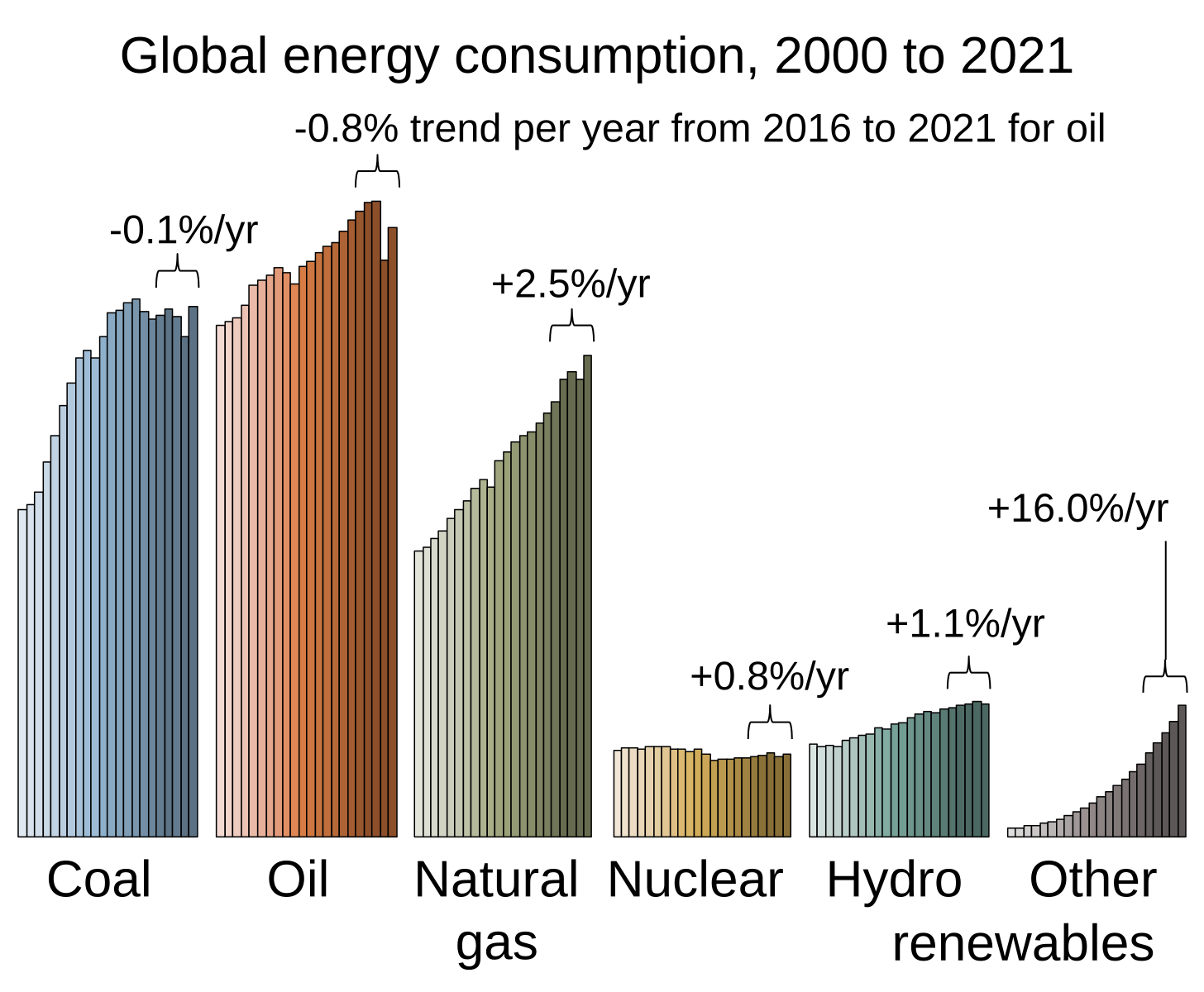IB Syllabus focus:
‘Population and per-capita use increase demand. Fossil dominance persists, yet reserves are finite; depletion timelines depend on consumption rates, discoveries, extraction tech, and growth of renewables/nuclear.’
Human reliance on energy is rapidly increasing, with global population growth and rising per-capita consumption driving unprecedented demand. Fossil fuels still dominate energy use despite their finite reserves.
Rising Global Energy Demand
Population Growth
One of the most significant drivers of energy demand is global population growth. As the number of people on the planet increases, the total need for energy rises correspondingly. Every additional individual requires energy for food production, housing, transportation, and industrial processes.
Per-Capita Energy Use
Beyond population, per-capita energy consumption has grown as societies industrialise and develop. In wealthier nations, lifestyles depend on high energy use for mobility, electronics, heating and cooling, and manufacturing. Even in emerging economies, rapid urbanisation and industrial expansion have boosted demand.
Developed countries: historically high per-capita energy use.
Developing countries: accelerating energy demand due to industrialisation and rising living standards.

Interactive line chart of primary energy use per person by country/region. It helps students connect rising per-capita consumption to overall demand growth discussed in the notes. The chart title and axis units are clearly labelled for study purposes. Source.
Dependence on Fossil Fuels
Fossil Fuel Dominance
Despite the growth of renewable energy, fossil fuels—coal, oil, and natural gas—continue to dominate the global energy mix. Their entrenched infrastructure, relative affordability, and high energy density make them the default sources of energy worldwide.

Stacked-area chart of global primary energy consumption by source, highlighting the sustained dominance of coal, oil, and natural gas relative to low-carbon sources. This directly illustrates the notes’ claim that fossil fuels still underpin the world’s energy supply. Axis labels and legends are clear and suitable for study use. Source.
Fossil Fuels: Energy sources formed from ancient organic matter, including coal, oil, and natural gas. They are non-renewable because they take millions of years to form.
This dominance persists even as alternatives expand, meaning global demand for fossil fuels remains central to discussions on sustainability.
Finite Nature of Fossil Resources
Resource Limits
Fossil fuel reserves are finite—once extracted and burned, they cannot be replaced on human timescales. The concept of resource depletion highlights the long-term unsustainability of relying heavily on these fuels.
Depletion Timelines
The rate at which fossil reserves are depleted depends on multiple factors:
Consumption rates: Higher consumption accelerates depletion.
Discoveries of new reserves: Exploration can extend supply timelines but becomes more difficult and expensive over time.
Extraction technology: Innovations such as hydraulic fracturing or deep-sea drilling can unlock previously inaccessible reserves.
Growth of renewables and nuclear energy: Wider adoption of alternatives can slow the rate of fossil depletion.

Schematic of the Hubbert curve illustrating production over time for a finite resource: growth, peak, and decline. This conceptual model supports the notes’ explanation of depletion timelines; it is a simplified representation and does not show specific real-world data points (extra detail beyond the syllabus: generalised curve shape). Source.
Technological Factors in Fossil Use
Extraction Technologies
New extraction technologies influence both supply and environmental impacts. Hydraulic fracturing, for example, has unlocked large shale gas reserves but raised concerns about groundwater contamination and seismic activity.
Efficiency Improvements
Technological advances in efficiency—such as more fuel-efficient vehicles or improved industrial processes—can reduce the rate of fossil fuel depletion by lowering demand.
Role of Renewable and Nuclear Energy
Substitution Effects
The rise of renewable energy sources like solar, wind, and hydro, along with the continued use of nuclear power, offers alternatives to fossil fuels. These can extend the longevity of reserves by reducing global dependence.
Renewable Energy: Energy derived from natural processes that replenish faster than they are consumed, such as solar, wind, hydro, and geothermal.
By substituting fossil energy with renewable or nuclear alternatives, societies can reduce both depletion rates and greenhouse gas emissions.
Interconnected Drivers of Energy Futures
Economic Growth
Rapid economic development fuels rising demand, particularly in countries transitioning from agrarian to industrial economies. Increased wealth also translates into higher energy consumption per person.
Political and Environmental Pressures
National policies, international agreements, and public pressure on climate change increasingly influence energy decisions. For example, restrictions on coal burning and carbon pricing aim to reduce fossil fuel reliance.
Geopolitical Implications
As fossil resources become harder to access, geopolitical tensions may arise over resource control. Nations with rich reserves often hold significant political leverage, creating potential for conflict.
Sustainability Implications
Unsustainable Trends
If current trends continue, fossil fuel depletion could occur within the next century for certain resources, particularly oil. Short-term economic priorities often overshadow the necessity of long-term planning.
Moving Toward Sustainability
For societies to manage rising energy demand sustainably, they must:
Expand renewable energy capacity.
Improve energy efficiency across sectors.
Develop international cooperation on resource sharing and technology transfer.
Transition economic models away from fossil dependency.
Key Points for IB Students
Rising demand is driven by both population growth and per-capita increases in consumption.
Fossil fuels dominate but are finite and non-renewable.
Depletion timelines vary depending on consumption, discoveries, technology, and substitution by renewables or nuclear power.
Sustainable energy management requires reducing fossil dependency while increasing reliance on renewable and nuclear alternatives.
FAQ
As countries industrialise, energy-intensive industries expand, leading to higher fossil fuel consumption.
Economic development also raises living standards, increasing demand for transportation, heating, cooling, and consumer goods. This creates a feedback loop where economic growth fuels greater energy demand, reinforcing dependence on fossil fuels.
Overall population growth raises total energy demand, but population density shapes how that demand is met.
High-density urban areas may rely more on centralised electricity and public transport.
Low-density regions often depend more heavily on private vehicles and distributed fuel use.
Thus, density alters not just the scale but also the pattern of fossil fuel consumption.
Fossil fuels benefit from decades of established infrastructure and economies of scale. Extraction, refining, and transport systems are already built, keeping marginal costs low.
Renewables often require new investment in technology, grid adaptation, or storage solutions. Subsidies and hidden costs, such as environmental damage, are rarely included in fossil fuel pricing, giving them an artificial advantage.
Geopolitical conflicts can accelerate depletion by restricting access to reserves, causing countries to exploit domestic supplies faster.
Conversely, trade restrictions or embargoes may delay depletion in certain regions by preventing access to foreign reserves. Political instability around oil and gas fields can therefore alter depletion timelines globally.
Consumer choices directly influence demand. Reduced air travel, energy-efficient appliances, and lower reliance on private cars all cut fossil fuel use.
Widespread behavioural changes, supported by education and policy, can slow depletion by lowering per-capita consumption, complementing technological and policy-driven solutions.
Practice Questions
Question 1 (2 marks)
Define the term fossil fuels and explain why they are considered non-renewable resources.
Mark scheme:
1 mark: Correctly defines fossil fuels as energy sources formed from ancient organic matter (coal, oil, natural gas).
1 mark: Explains that they are non-renewable because they take millions of years to form and cannot be replenished on human timescales.
Question 2 (5 marks)
Discuss two factors that influence the timeline of fossil fuel depletion and explain how each factor can either extend or shorten the availability of fossil fuels.
Mark scheme:
1 mark: Identifies consumption rates as a factor.
1 mark: Explains higher consumption shortens depletion timelines, while reduced consumption extends them.
1 mark: Identifies technological advances or discoveries of new reserves as a factor.
1 mark: Explains that new reserves or improved extraction technologies can extend timelines.
1 mark: Explanation shows clear link between factor and its impact (must mention both directions: extend vs shorten).

